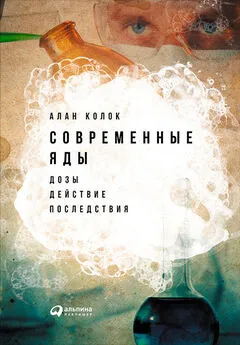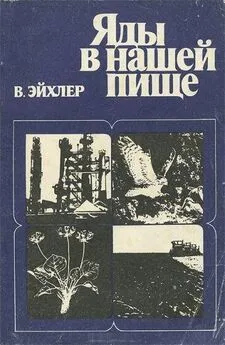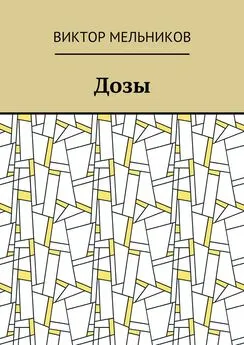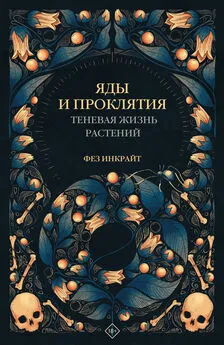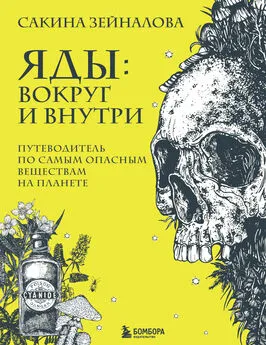Алан Колок - Современные яды: Дозы, действие, последствия
- Название:Современные яды: Дозы, действие, последствия
- Автор:
- Жанр:
- Издательство:Альпина Паблишер
- Год:2017
- Город:Москва
- ISBN:978-5-9614-4570-1
- Рейтинг:
- Избранное:Добавить в избранное
-
Отзывы:
-
Ваша оценка:
Алан Колок - Современные яды: Дозы, действие, последствия краткое содержание
Вы узнаете из книги о том, что происходит в мире токсикологии сейчас, как и для чего ученые разрабатывают всё новые смертоносные яды, под какими красивыми масками они нам преподносятся, как проникают в наш организм и какие последствия вызывают, и, конечно, о тех маленьких бездумных преступлениях против окружающей среды, которые мы ежедневно совершаем не задумываясь. Библиотека электронных книг и журналов
Современные яды: Дозы, действие, последствия - читать онлайн бесплатно ознакомительный отрывок
Интервал:
Закладка:
Cohen, S. M., L. L. Arnold, M. Cano, M. Ito, E. M. Garland, and R. A. Shaw. "Calcium Phosphate-Containing Precipitate and the Carcinogenicity of Sodium Salts in Rats." Carcinogenesis 21 (2000): 783–92.
Gold, L. S., T. H. Slone, N. B. Manley, and L. Bernstein. "Target Organs in Chronic Bioassays of 533 Chemical Carcinogens." Environmental Health Perspectives 93 (1991): 233–46.
Gold, L. S., L. Bernstein, R. Magaw, and T. H. Slone. "Interspecies Extrapolation in Carcinogenesis: Prediction between Rats and Mice." Environmental Health Perspectives 81 (1989): 211–219.
Harvey-Clark, C. "IACUC Challenges in Invertebrate Research." ILAR Journal 52 (2011): 213–20.
Hurst, L. D., and N. G. Smith. "Do Essential Genes Evolve Slowly?" Current Biology 9 (1999): 747–50.
Jordan, I. K., I. B. Rogozin, Y. I. Wolf, and E. V. Koonin. "Essential Genes Are More Evolutionarily Conserved than Are Nonessential Genes in Bacteria." Genome Research 12 (2002): 962–68.
Kawakami, T., R. Ishimura, K. Nohara, K. Takeda, C. Tohyama, and S. Ohsako. "Differential Susceptibilities of Holtzman and Sprague-Dawley Rats to Fetal Death and Placental Dysfunction Induced by 2,3,7,8-teterachlorodibenzo-p-dioxin (TCDD) despite the Identical Primary Structure of the Aryl Hydrocarbon Receptor." Toxicology and Applied Pharmacology 212 (2006): 224–36.
Mather, J. A. "Philosophical Background of Attitudes toward the Treatment of Invertebrates." ILAR Journal 52 (2011): 205–12.
Putz, O., C. B. Schwartz, S. Kim, G. A. LeBlanc, R. L. Cooper, and G. S. Prins. "Neonatal Low– and High-Dose Exposure to Estradiol Benzoate in the Male Rat: I. Effects on the Prostate Gland." Biology of Reproduction 65 (2001): 1496–505.
Putz, O., C. B. Schwartz, G. A. LeBlanc, R. L. Cooper, and G. S. Prins. "Neonatal Low– and High-Dose Exposure to Estradiol Benzoate in the Male Rat: II. Effects on Male Puberty and the Reproductive Tract." Biology of Reproduction 65 (2001): 1506–17.
Rand-Weaver, M., L. Margiotta-Casaluci, A. Patel, G. H. Panter, S. F. Owen, and J. P. Sumpter. "The Read-Across Hypothesis and Environmental Risk Assessment of Pharmaceuticals." Environmental Science and Technology 47 (2013): 11 384–95.
Rinaldi, J., J. Wu, J. Yang, C. Y. Ralston, B. Sankaran, S. Moreno, and S. S. Taylor. "Structure of Yeast Regulatory Subunit: A Glimpse into the Evolution of PKA Signaling." Structure 18 (2010): 1471–82.
Rothen, D., S. Baran, and M. Perret-Gentil. "Are Zebrafish the New Mice?" ALN magazine (2014). http://www.alnmag.com/articles/2014/06/are-zebrafish-new-mice
Vargo-Gogola, T., and J. M. Rosen. "Modeling Breast Cancer: One Size Does Not Fit All." Nature Reviews Cancer 7 (2007): 659–72.
Abbott, N. J. «Blood – Brain Barrier Structure and Function and the Challenges for CNS Drug Delivery.» Journal of Inherited Metabolic Disease 36 (2013): 437–49.
Pardridge, W. M. "Drug Delivery to the Brain." Journal of Cerebral Blood Flow and Metabolism 17 (1997): 713–31.
Patel, M. M., B. R. Goyal, S. V. Bhadada, J. S. Bhatt, and A. F. Amin. "Getting into the Brain." CNS Drugs 23 (2009): 35–58.
Blackwell, B. R., K. J. Wooten, M. D. Buser, B. J. Johnson, G. P. Cobb, and P. N. Smith. «Occurrence and Characterization of Steroid Growth Promoters Associated with Particulate Matter Originating from Beef Cattle Feedyards.» Environmental Science and Technology 49 (2015): 8796–803.
Hamra, G. B., N. Guha, A. Cohen, F. Laden, O. Raaschou-Nielsen, J. M. Samet, P. Vineis, et al. "Outdoor Particulate Matter Exposure and Lung Cancer: A Systematic Review and Meta-Analysis." Environmental Health Perspectives 122 (2014): 906–11. doi:10.1289 / ehp.1408092.
Jonker, M. T. O., and L. van Mourik. "Exceptionally Strong Sorption of Infochemicals to Activated Carbon Reduces Their Bioavailability to Fish." E nvironmental Toxicology and Chemistry 33 (2014): 493–99.
Liu, L., B. Urch, R. Poon, M. Szyszkowicz, M. Speck, D. R. Gold, A. J. Wheeler, et al. "Effects of Ambient Coarse, Fine, and Ultrafine Particles and Their Biological Constituents on Systemic Biomarkers: A Controlled Human Exposure Study." Environmental Health Perspectives 123 (2015): 534–40. doi:10.1289/ehp.1408387.
McEachran, A. D., B. R. Blackwell, J. D. Hanson, K. J. Wooten, G. D. Mayer, S. B. Cox, and P. N. Smith. "Antibiotics, Bacteria, and Antibiotic Resistance Genes: Aerial Transport from Cattle Feed Yards via Particulate Matter." Environmental Health Perspectives 123 (2015): 337–43. doi:10.1289/ehp.1408555.
Sandstrom, T., and B. Forsberg. "Desert Dust: An Unrecognized Source of Dangerous Air Pollution?" Epidemiology 19 (2008): 808–9.
Valavanidis, A., K. Fiotakis, and T. Vlachogianni. "Airborne Particulate Matter and Human Health: Toxicological Assessment and Importance of Size and Composition of Particles for Oxidative Carcinogenic Mechanisms." Journal of Environmental Science and Health Part C: Environmental Carcinogenesis Ecotoxicology Reviews 26 (2008): 339–62. doi:10.1080/10590500802494538.
Vignati, D. A., T. Dworak, B. Ferrari, B. Koukal, J. L. Loizeau, M. Minouflet, M. I. Camusso, S. Polesello, and J. Dominik. "Assessment of the Geochemical Role of Colloids and Their Impact on Contaminant Toxicity in Freshwaters: An Example from the Lambro-Po System (Italy)." Environmental Science and Technology 39 (2005): 489–97.
Von Essen, S. G., and B. W. Auvermann. "Health Effects from Breathing Air Near CAFOs for Feeder Cattle or Hogs." Journal of Agromedicine 10 (2005): 55–64.
Fry, B. G. «From Genome to 'Venome': Molecular Origin and Evolution of the Snake Venom Proteome Inferred from Phylogenetic Analysis of Toxin Sequences and Related Body Proteins.» Genome Research 15 (2005): 403–20.
Clarkson, T. W. «The Three Modern Faces of Mercury.» Environmental Health Perspectives 110 (2002): 11–23.
Diamond, G. L., P. E. Goodrum, S. P. Felter, and W. L. Ruoff. "Gastrointestinal Absorption of Metals." Drug and Chemical Toxicology 21 (1998): 223–51.
Hakim, J. "The Story of the Atom." American Federation of Teachers (2002): 12–25.
Le, T. T., W. J. Peijnenburg, A. J. Hendriks, and M. G. Vijver. "Predicting Effects of Cations on Copper Toxicity to Lettuce ( Lactuca sativa ) by the Biotic Ligand Model." Environmental Toxicology and Chemistry 31 (2012): 355–59.
Lessler, M. A. "Lead and Lead Poisoning from Antiquity to Modern Times." Ohio Journal of Science 88 (1988): 78–84.
Nicole, W. "Evolutionary Selection for Arsenic Resistance: The Case of the Atacamenos of the Andes Highlands." Environmental Health Perspectives 121 (2013): A31.
Niyogi, S., and C. H. Wood. "Biotic Ligand Model, a Flexible Tool for Developing Site-Specific Water Quality Guidelines for Metals." Environmental Science and Technology 38 (2004): 6177–92.
Paquin, P. R., J. W. Gorsuch, S. Apte, G. E. Batley, K. C. Bowles, P. G. C. Campbell, C. G. Delos, et al. "The Biotic Ligand Model: A Historical Overview." Comparative Biochemistry and Physiology Part C 133 (2002): 3–35.
Przygoda, G., J. Feldmann, and W. Cullen. "The Arsenic Eaters of Styria: A Different Picture of People Who Were Chronically Exposed to Arsenic." Applied Organometallic Chemistry 15 (2001): 457–62.
Ashby, J., and D. Paton. «The Influence of Chemical Structure on the Extent and Sites of Carcinogenesis for 522 Rodent Carcinogens and 55 Different Human Carcinogen Exposures.» Mutation Research 286 (1993): 3–74.
Creton, S., M. J. Aardema, P. L. Carmichael, J. S. Harvey, F. L. Martin, R. F. Newbold, M. R. O'Donovan, et al. "Cell Transformation Assays for Prediction of Carcinogenic Potential: State of the Science and Future Research Needs." Mutagenesis 27 (2012): 93–101.
DeVita, V. T. Jr., and E. Chu. "A History of Cancer Chemotherapy." Cancer Research 68 (2008): 8643–53.
Melicow, M. M. "Percivall Pott (1712–1788): 200th Anniversary of First Report of Occupation-Induced Cancer of Scrotum in Chimney Sweepers (1775)." Urology 6 (1975): 745–49.
Miller, E. C. "Some Current Perspectives on Chemical Carcinogenesis in Humans and Experimental Animals: Presidential Address." Cancer Research 38 (1978): 1479–96.
Miller, J. A. "Carcinogenesis by Chemicals: An Overview – G. H. A. Clowes Memorial Lecture." Cancer Research 30 (1970): 559–76.
Triolo, V. A., and I. L. Riegel. "The American Association for Cancer Research, 1907–1940. Historical Review." Cancer Research 21 (1961): 137–67.
Blum, K., J. G. Cull, E. R. Braverman, and D. E. Comings. «Reward Deficiency Syndrome.» American Scientist 84 (1996): 132–45.
Blum, K., A. L. C. Chen, J. Giordano, J. Borsten, T. J. H. Chen, M. Hauser, T. Simpatico, J. Femino, E. R. Braverman, and D. Barh. "The Addictive Brain: All Roads Lead to Dopamine." Journal of Psychoactive Drugs 44 (2012): 134–43.
De Pasquale, A. "Pharmacognosy: The Oldest Modern Science." Journal of Ethnopharmacology 11 (1984): 1–16.
Glander, K. E. "Nonhuman Primate Self-Medication with Wild Plants." Chap. 12 in Eating on the Wild Side: The Pharmacologic, Ecologic, and Social Implications of Using Noncultigens. Tucson, AZ: University of Arizona Press, 1994.
Hardy, K., S. Buckley, M. J. Collins, A. Estalrrich, D. Brothwell, L. Copeland, A. Garcнa-Tabernero, et al. "Neanderthal Medics? Evidence for Food, Cooking, and Medicinal Plants Entrapped in Dental Calculus." Naturwissenschaften 99 (2012): 617–26. doi:10.1007 / s00114-012-0942-0. Epub 2012 Jul 18.
Huffman, M. A. "Current Evidence for Self-Medication in Primates: A Multidisciplinary Perspective." Yearbook of the Journal of Physical Anthropology 40 (1997): 171–200.
Jones, A. W. "Early Drug Discovery and the Rise of Pharmaceutical Chemistry." Drug Testing and Analysis 3 (2011): 337–44.
Nichols, D. E. "Hallucinogens." Pharmacology and Therapeutics 101 (2004): 131–81.
Quaglio, G., A. Fornasiero, P. Mezzelani, S. Morechini, F. Lugoboni, and A. Lechi. "Anabolic Steroids: Dependence and Complications of Chronic Use." Internal and Emergency Medicine 4 (2009): 289–96.
Sullivan, R. J., and E. H. Hagen. "Psychotropic Substance-Seeking: Evolutionary Pathology or Adaptation?" Addiction 97 (2002): 389–400.
Tan, R. S., and M. C. Scally. "Anabolic Steroid-Induced Hypogonadism: Towards a Unified Hypothesis of Anabolic Steroid Action." Medical Hypotheses 72 (2009): 723–28.
Westermeyer, J. "The Pursuit of Intoxication: Our 100-Century-Old Romance with Psychoactive Substances." American Journal of Drug and Alcohol Abuse 14 (1988): 175–87.
Wood, R. I. "Reinforcing Aspects of Androgens." Physiology and Behavior 83 (2004): 279–89.
Bouwman, H., H. van den Berg, and H. Kylin. «DDT and Malaria Prevention: Addressing the Paradox.» Environmental Health Perspectives 119 (2011): 744–47.
Читать дальшеИнтервал:
Закладка:
